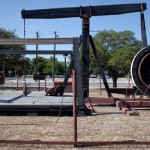Where Not to Put the Keystone XL Pipeline
The Canadian company behind the proposed Keystone XL pipeline, which would bring crude from the country’s oil sands to refineries in Texas, got a little gift to end out the year from the Nebraska government this week: a map of where not to put the pipeline.
The pipeline ran into a snag earlier this year after Nebraska lawmakers opposed the route planned by the company, TransCanada, which would have gone through an environmentally-sensitive region known as the Nebraska Sandhills. The Sandhills are home to a giant freshwater aquifer that is used for water supply. (The pipeline also met with opposition from several environmental groups, who said it would increase reliance on fossil fuels.)
The ground is so thin in some parts of the area that groundwater on occasion rises to the surface. Water there is used primarily for irrigation, but it’s also used for drinking water by some 2 million people, according to the US Geological Survey.
Nebraska lawmakers passed legislation in November saying an alternative route that avoids the Sandhills must be found in order for the project to go forward. With the release of this map, it seems Nebraska wants to give the pipeline company that opportunity.
The magic number for the pipeline these days is sixty: just sixty miles of pipeline that have to be re-routed around the sand hills region of Nebraska (or about 3.5 percent of the entire project, which would total 1,700 miles), and just sixty days for the Obama administration to make a decision on it.
If a route can be found around or through the sand hills, it’s possible the project could be approved. A spokesperson for TransCanada told the The Canadian Press Tuesday that the sand hills section is the only one that needs to be figured out, as the rest of the pipeline has virtually been approved. “It’s not overriding some environmental review that has to take place,” TransCanada spokesperson Shawn Howard told the news agency, “It’s not changing that review. This bill was carefully crafted, it respected that.”
That bill he’s referring to is the one passed by the U.S. Congress last week and signed by the president to extend the payroll tax cut and force a decision by the Obama administration on the pipeline within sixty days. TransCanada says the bill speeds up the construction process. And now the company has an exact idea of what areas they must avoid.
“Obviously, the applicant cannot propose the route without knowing the area to be avoided,” Nebraska Department of Environmental Quality (NDEQ) Director Mike Linder said in a statement announcing the release of the map. “NDEQ has been reviewing available information and has selected a map of ecoregions which was finalized in 2001 as best depicting the Sandhills region.”
Here’s the map from the Nebraska Department of Environmental Quality (NDEQ). The yellow shading represents the Sandhills region:

Map by Nebraska Department of Environmental Quality
This map shows areas the Keystone Pipeline must avoid
It appears at a glance that there is a gap for the pipeline to go through that could meet the requirements of the Nebraska government. Now it’s up to TransCanada to use this map and submit an alternate route for consideration, the NDEQ says.
UPDATE: Here is a map of the proposed pipeline created by NPR:




